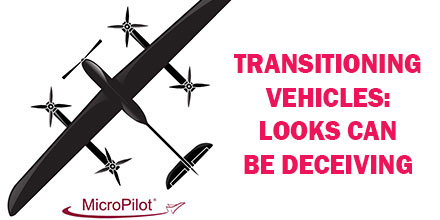Quad-planes and Tilt-rotors
There are two main types of transitioning vehicles: quad-planes and tilt-rotors.
The quad-plane uses a separate set of motors and propellers for lifting than it does for forward flight. During hover, the forward flight motor is off and during forward flight, the lifting motors are off.
The tilt-rotor shares lifting and forward flight motors. Two, or more, of the lifting motors/propellers tilt forward during the transition from hovering to forward flight. They tilt back to vertical during the transition back to hovering flight.
Of course, there is a price to pay for the ability of a fixed wing UAV to hover: complexity, cost, and weight all increase.
Drag also increase, which has significant effect on endurance. This effect is great enough that transitioning vehicles make much more sense for gas powered UAVs.
It isn’t difficult to design a fixed wing UAV with an endurance of ten, or more, hours. Sacrificing a couple hours endurance for the ability to hover is a decent trade-off.
In an all-electric UAV, the endurance is less and the cost of the ability to hover is a much larger percent of the UAV’s overall endurance.
Propeller Considerations
When comparing a quad-plane style UAV to a tilt-rotor, the designer might consider the reduction in the number of motors an advantage. Again, this advantage comes at a cost related to the propellers’ pitch. The optimum propeller pitch for forward flight is different from the optimum pitch for hovering.
Since a quad-plane uses different propellers for forward flight than it does for hovering, the designer is free to choose the most efficient propeller for each phase of flight.
The designer of a tilt-rotor does not have this freedom. A compromise occurs between a propeller optimized for hovering versus one optimized for forward flight. As such, the designer must either accept less payload or less endurance.
Another disadvantage of tilt-rotors is they must use electric propulsion. You cannot mix a gas engine for forward flight with electric motors for hovering.
Endurance is not the only challenge when designing a transitioning UAV. Wind also presents some challenges, primarily when hovering.
Vertical Stabilizer
When flying a quad-plane in a wind, the wind creates airflow over the wings and tail of the quad-plane and this generates forces that are a challenge for the quad-plane.
The most obvious problem comes from the vertical stabilizer. If the vertical stabilizer is not aligned with the wind, it generates a yawing moment that tries to turn the UAV into the wind.
The problem is that while multi-rotors have excellent pitch and roll control, their yaw control is weak. It is very easy for the torque generated by the vertical stabilizer to overwhelm the quad-plane’s ability to hold a heading when hovering in a wind.
This can be a problem if the direction you are facing when your UAV transition to forward flight matters.
For example, if hovering near a structure and the wind turns the quad-plane so that it is facing the structure, it cannot transition without hitting the structure. Tilt-rotors do not suffer from this drawback as you can control yaw by tilting one of the motors. This provides very strong yaw control.
Airflow
Another problem is airflow over the wing when hovering in a wind.
In order to hover in a wind, the quad-plane must tilt into the wind. This puts the wing at a negative angle of attack and the wing will generate lift in the downward direction.
Now the lifting motors must lift not just the weight of the UAV but must also overcome the force generated by the wing. This is a significant challenge because quad-planes are usually heavy – near the maximum lifting capacity of its motors, and the wing’s downward force can seriously limit the UAV’s ability to climb when hovering in a wind.
The usual solution to this problem is to use the quad-plane’s forward flight engine to help hold position.
The quad-plane can then hold a more level attitude and the airflow over the wing can help the quad-plane climb. Note that using the forward flight engine only helps if the quad-plane is pointed into the wind. Tilt-rotors also suffer from this challenge. A tilt-rotor can tilt its motors into the wind to help hold position.
Center of Gravity
Another complication with both a quad-plane and a tilt-rotor is the center of gravity. The UAV designer has essentially combined two UAVs into one and each of the two UAVs needs the center of gravity in the correct location.
The multi-rotor works best if the center of gravity is located centrally between the motors. The fixed wing needs the center of gravity about a third of the distance between the wing’s leading and trailing edges.
It is not difficult to arrange the correct center of gravity, but it is another detail that needs attention.
As with all UAVs, the designer of a transitioning UAV faces many trade-offs. The correct choice is dictated by the task the UAV must perform. Given the very poor yaw control of a quad plane and the tilt-rotor’s inability to combine gas and electric motors; it may be worth considering a hybrid of hybrids.
A quad-plane with tilting motors to ensure adequate yaw control provides the best of both worlds and is likely worth the cost and weight of the extra tilting mechanisms.
 Transitioning UAVs, which combine fixed-wing aircraft with a multi-rotor, seem to be a favored development craft these days.
Transitioning UAVs, which combine fixed-wing aircraft with a multi-rotor, seem to be a favored development craft these days.
